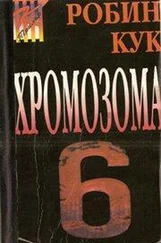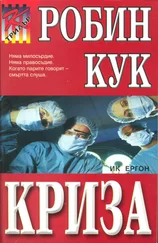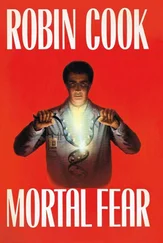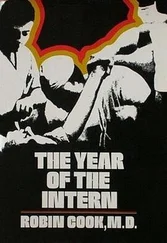“What brings you up here two nights in a row?” asked the resident.
“Pap smears,” said Philips with no preamble.
“I suppose you have an emergency slide for me to read,” said Barnes sarcastically.
“No. I just want some information. I want to know if radiation can cause an atypical Pap smear.”
Barnes thought for a moment before answering. “I’ve never heard of it from diagnostic radiology but certainly radiotherapy will affect the cervical cells and hence the Pap smear.”
“If you looked at an atypical smear, could you tell if it was caused by radiation?”
“Maybe,” said Barnes.
“Remember those slides you looked at for me last night?” continued Philips. “The brain sections. Could those nerve-cell lesions be caused by radiation?”
“I kinda doubt it,” said Barnes. “The radiation would have to have been aimed with a telescopic sight. The nerve cells right next to the damaged ones looked fine.”
Philips face went blank while he tried to put together the inconsistent facts. The patients had absorbed enough radiation to show up on a X ray, yet on a cellular level, one cell was totally knocked out while a neighbor was all right.
“Are Pap smear specimens saved?” he asked finally.
“I think so. At least for a while, but not here. They’re over in the Cytology lab, which operates on bankers’ hours. They’ll be in in the morning after nine.”
“Thanks,” said Philips, sighing. He wondered if he should try to get into the lab right away. Perhaps if he called Reynolds. He was about to leave when he thought of something else. “When they read Pap smears, is the result in the chart just the classification, or do they describe the pathology?”
“I think so,” said Barnes. “The results are stored on tape. All you need is the patient’s unit number and you can read the report.”
“Thanks a lot,” said Philips. “I know you’re busy so I appreciate your time.”
Barnes gave a slight nod of acknowledgment, then put his eyes back to his microscope.
The Pathology computer terminal was separated from the lab by a series of room dividers. Pulling up a chair, Martin sat down in front of the unit. It was similar to the terminal in Radiology with a large TV-like screen directly behind the keyboard. Taking out the list of five patients, Philips keyed in the name Katherine Collins, followed by her unit number and the code for Papanicolaou Smear. There was a pause, then letters appeared on the screen as if someone were typing. First it spelled out Katherine Collins very rapidly, followed by a slight pause. Then the date of the first Pap smear followed by:
Adequate smear, good fixation, and proper staining. Cells show normal maturation and differentiation. Estrogen effect normal: 0/20/80. A few candida organisms seen. Result: negative.
Philips checked the date of the first smear while the machine spelled out the next report. The date corresponded to the first date Philips had written on the list. Looking back up at the computer screen, Philips’ disbelieving eyes read that the second Pap smear on Collins was also negative!
Philips cleared the screen and rapidly entered Ellen McCarthy’s name, her unit number, and the proper code. He felt his stomach tighten into a knot as the machine began to spell out the information. It was the same — negative!
As he went back downstairs, Martin felt stunned. In medicine he had learned to believe what he read in charts, especially in regard to laboratory reports. They were the objective data while the symptom of the patients and the impressions of the doctors were the subjective. Philips knew that there was a small chance there could be an error in laboratory tests just as he knew there was a possibility that he could miss or misinterpret something on an X ray. But the low probability of error was a far cry from deliberate falsification. That required some sort of conspiracy, and Philips took it very personally.
Sitting at his desk, Martin cradled his head in his hands and rubbed his eyes. His first impulse was to call the hospital authorities, but that meant Stanley Drake, and he decided against it. Drake’s response would be to keep it out of the papers, cover it up. The police! Mentally he ran through a hypothetical conversation: “Hello, I’m Dr. Martin Philips and I want to report that something funny is going on at Hobson University Medical Center. Girls get Pap smears that are normal but are entered into the chart as atypical.” Philips shook his head. It sounded too ridiculous. No, he needed more information before the police were involved. Intuitively he felt the radiation was connected even though it didn’t make any sense. In fact, radiation might cause an atypical Pap smear and it seemed to Philips that if someone wanted to avoid discovery of the radiation, they might report atypical Paps as normal, but not vice versa.
Philips thought again about the diener. After their abortive meeting the previous evening, Martin had been convinced Werner knew more about Lisa Marino than he’d been willing to disclose. Perhaps one hundred dollars wasn’t enough. Maybe Philips should offer more. After all, the affair was no longer an academic exercise.
Martin realized that trying to successfully confront Werner in the morgue was an impossibility. Surrounded with the dead, Werner was in his element, whereas Martin found the place totally unnerving and he knew he would have to be forceful and demanding if Werner was going to be made to talk. Philips glanced at his watch. It was twenty-five after eleven. Werner obviously worked the evening shift, four to midnight. Impulsively Martin decided he’d follow Werner home and offer him five hundred dollars.
With some trepidation he dialed Denise’s number. It rang six times before a sleepy voice answered: “Are you coming over?”
“No,” said Philips evasively. “I’m in the middle of something and I’m going to keep at it.”
“There’s a nice warm spot here for you.”
“We’ll make up for it this weekend. Sweet dreams.”
Martin got his dark blue ski parka out of his closet and put on the Greek captain’s cap he found in the pocket. It was April but the drizzly weather had brought in wind from the northeast and it was chilly.
He left the hospital through the emergency room, leaping from the platform to the puddle-strewn tarmac of the parking area. But instead of walking out to the street, he turned right, round the corner of the main hospital building and headed down a canyon formed by the north face of the Brenner Childrens Hospital. After fifty yards it opened up to the inner courtyard of the Med Center.
The hospital buildings soared up into the misty night like sheer cliffs forming an irregular cement valley. The Med Center had been built in spurts without the benefit of a rational overall plan. This fact was obvious in the courtyard, where buildings impinged upon the space with chaotic angles and buttresses. Philips recognized the small wing that housed Goldblatt’s office, and using that as a landmark, was able to orient himself. It was only about twenty-five yards farther on that he found the unmarked platform that he knew led into the depths of the morgue. The hospital did not like to advertise that it dealt in death, and the bodies were stealthily excreted into the waiting black hearses far from the public eye.
Martin leaned up against the wall and thrust his hands into his pockets. While he waited he tried to review the complicated events he’d experienced since Kenneth Robbins had handed him Lisa Marino’s X ray. It hadn’t even been two days, yet it seemed like two weeks. The initial excitement that he’d felt seeing the strange radiologic abnormality had now changed to a hollow fear. He almost dreaded to find out what was going on in the hospital. It was like a sickness in his own family. Medicine had been his life. If it weren’t for his immediate sense of responsibility about Kristin Lindquist, he wondered if he’d just forget what he knew. Goldblatt’s tirade about professional suicide rang in his ears.
Читать дальше












